
Limbo: Loading the Doom Buggies
Boundless mist and decay
After leaving the hallway of changing portraits at Disneyland, patrons of the Haunted Mansion arrive at a "limbo of boundless mist and decay" (according to the narrator of the "Story and Song from The Haunted Mansion" record album.) This strange, cloud-shrouded area is the Doom Buggy loading area, which contains a constantly moving walkway that enables guests to be seated in a "Doom Buggy," which is a black carriage that can hold up to three passengers and is equipped with high fidelity stereo speakers that broadcast audio received through a digital signal.
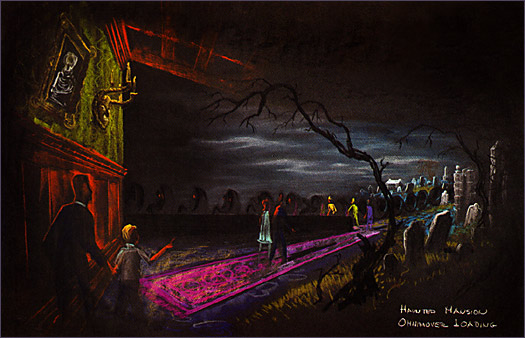
Riding through a misty Mansion
The concept sketch above is by Imagineer Claude Coats, and it represents the "limbo" space he imagined for the loading area. In this case, the area would have represented a sort of netherworld combing elements from the Mansion's exterior and interior, encapsulating the whole Haunted Mansion experience in a way, which other dark rides often do at their loading docks (often via the use of murals). As it stands, the limbo areas in the various Haunted Mansions are mostly darkened spaces, often featuring spider webs and candleabra. Beyond jumbo spiders, exterior elements never made it into the load areas at any of the Haunted Mansions.
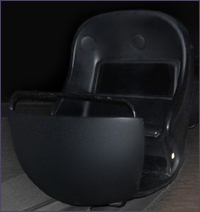 Boarding
the "clamshells"
Boarding
the "clamshells"
It could be argued that the most complex and significant design detail
of the entire ride is the Doom Buggy, which is another name for the "Omnimover"
system vehicle developed by WED for Disneyland's "Adventure Thru Inner
Space" attraction. (The Omnimovers were also affecionately known as
"clamshells" by operators of "Inner Space" and, later,
the Haunted Mansion.) The Doom Buggy's unique form was initially designed
by WED transportation designer Bob Gurr. At a DoomBuggies.com event in February
2008, Gurr recalled that the design he created was inspired by a flattened
candy apple that he had sitting on his desk at the time.
This ride transport system keeps the guests a specific distance from each effect, and allows each rider a narrow point of view. This then enabled the Mansion's designers to design the attraction cinematically. The Mansion has set "scenes," much like a movie does, and most visitors see pretty much exactly the same thing, no matter where they try to look.

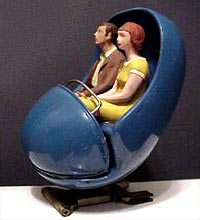
Early Omnimovers
The first attraction to utilize the Omnimover system was Disneyland's "Adventure Thru Inner Space," a ride presented originally by Monsanto which took guests through a "Mighty Microscope" into the world of the atom via a lone snowflake. Originally marketed as a somewhat "psychedelic" ride, "Inner Space" was designed cinematically (in much the same way as the Haunted Mansion is) with many sets designed with central points of view. Located in the same show building that now hosts "Star Tours," "Inner Space" carried the Omnimovers through a winding track through the unstable world of a molecule inside a melting snowflake. The adventure also featured a dramatic soundtrack by Paul Frees, the voice of the Haunted Mansion's Ghost Host. Pictured above is a model "Atom Mobile" which was used in the actual "Inner Space" attraction.

Writer Christopher Finch, who wrote The Art of Walt Disney (ISBN: 0810927020) as well as many other Disney art publications, comments about the Doom Buggies in the aforementioned book:
"In the Haunted Mansion, as in many other attractions at the parks,
another kind of vehicle - a car that runs on rails - is substituted for
the camera. The show begins with a teaser - a device planned to set the
atmosphere and to draw the viewer into the unfolding situation. The floor
begins to drop and… immediately establishes a sense of insecurity,
but it has the added practical purpose of bringing visitors down to a basement
level where they board the cars that take them through the rest of the show.
These cars carry the guests through a sequence of spooky environments, each
of which exposes them to a new kind of "supernatural" phenomenon...
The cars, each wired for stereo sound, are built in such a way that the
rider can see only what is directly in front of him. Each car is on a swivel
so that it can be turned, by electronic signals, to face just what the designer
wants it to face at any particular moment. In this sense, then, it is used
exactly like a movie camera. The rider is traveling through a programmed
show which unfolds in time. The choice of where to look is not his to make—it
has already been made by the designer, who determines what will be seen,
just as a director determines what the movie patron will see."
Omnimovin'...
As guests step onto the moving walkway that enables them to be seated on one of the constantly-moving Doom Buggies, a Haunted Mansion cast member is always nearby to ensure that they make it on board before the Doom Buggy disappears into the darkness. The Omnimovers include a steel bar which is attached to the front of the carriage. The entire front panel is lowered to allow guests to board, and then is automatically raised into position just before the moving walkway ends and the carriage continues on, into the dark recesses of the Haunted Mansion.
The Omnimover system was created by WED (with Gurr handling a large part of the design personally), but manufactured by Arrow Dynamic. Dana Morgan, with Arrow back in the late '60s, recalls the intricacy of the "Doom Buggy" carriages:
"They were extremely difficult to make. They were designed at WED, now WDI, and Arrow was primarily a manufacturer, though we were involved in some of the refining of it. The Omnimover is constructed with steel pipe rail track located below the artificial floor. The artificial floor is three-and-a-half to four feet above the concrete floor level. A continuous string of vehicles are linked together. They are driven, in this case, by a pinch wheel system. There are fins on all the cars and the pinch wheels drive them. Every 250 feet or so a series of pinch wheels would push the fins. The way we do it now is, we power every third vehicle with an onboard electric motor. I kind of prefer that, but both systems work. The cam path allows the vehicles to rotate. What was unusual about this system, was through a multiplication system, it could turn almost 360 degrees. It could turn clear around. It also had a tipping mechanism in it, so if you went up or downhill, you wouldn't go uphill on an angle."
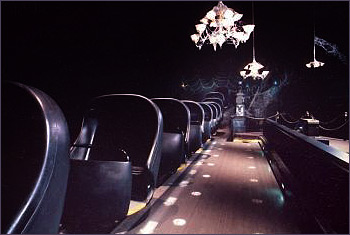 "You
could tip it so the vehicle was still nominally vertical, or in some cases,
we would actually profile them to lay back a little bit so they would feel
secure, as if they are leaning back in their seat.It was done with two cam
paths: one cam for side to side, and a second cam for vertical. This was
really a Disney design, and we built these for them and participated in
that. it was very successful, with many originals still operating today.
They're a bear to make, and they're very complicated. They are all castings
and precision machining. Very expensive."
"You
could tip it so the vehicle was still nominally vertical, or in some cases,
we would actually profile them to lay back a little bit so they would feel
secure, as if they are leaning back in their seat.It was done with two cam
paths: one cam for side to side, and a second cam for vertical. This was
really a Disney design, and we built these for them and participated in
that. it was very successful, with many originals still operating today.
They're a bear to make, and they're very complicated. They are all castings
and precision machining. Very expensive."
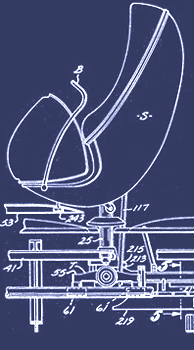 Dana
Morgan's comments about the Doom Buggies came from a book called "Roller
Coasters, Flumes, and Flying Saucers" by Robert R. Reynolds (Click
here to buy a copy from Amazon.com). The book has lots of great technical
ride system data from Disneyland's earliest attractions. It's a must read
for anyone very interested in industrial design or theme park history.
Dana
Morgan's comments about the Doom Buggies came from a book called "Roller
Coasters, Flumes, and Flying Saucers" by Robert R. Reynolds (Click
here to buy a copy from Amazon.com). The book has lots of great technical
ride system data from Disneyland's earliest attractions. It's a must read
for anyone very interested in industrial design or theme park history.
Pictured at left is an illustration from Disney's actual patent on the Omnimover system. This illustration helps describe the intricacy of the vehicle as described above by Dana Morgan. Notice how far below the Doom Buggy base the track actually lies.
By the numbers
At Walt Disney World, there are 160 Doom Buggies looping the track at once, moving at approximately 1.4 miles per hour. Disneyland's track is a bit shorter, so the Anaheim attraction can only hold 131 vehicles. With each Doom Buggy moving at two feel per second, this should allow almost 2,500 guests to take a tour of the Mansion each hour at either park.




